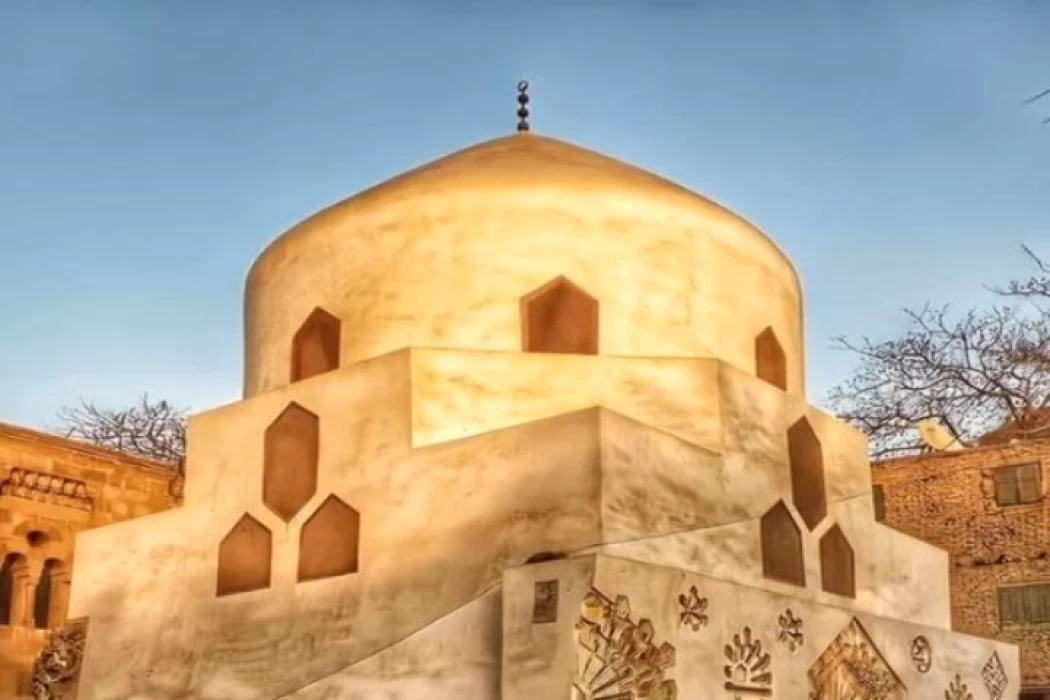
Mausoleum of Shajarat EL-Dor | Shajarat EL-Dor Tomb
This small mausoleum was built by Shajar al-Durr, the sultana who ruled Egypt for eighty days in 648 AH / 1250 AD after the death of her husband, Sultan Salih Najm al-Din, the last of the Ayyubid sultans. During her short reign, Shajar al-Dur built a mausoleum for al-Salih near his school in Bain al-Kasserine, as well as her soil complex in the cemetery of Sayyida Nafisa. You may have chosen this site due to its proximity to many of the tombs of the women of the Al-Bayt family, as it is located near the tombs of Mrs. Atika, Mrs. Ruqayya, and Mrs. Sakina. Its dome is a small building, originally part of a larger complex that included a bathroom, a house, and a school surrounded by a garden. The dome was designed in the "Fatimid-Ayyubid" style prevalent at the time, with decorative stucco beams on the facades, and tambours in the areas between the windows.

Mausoleum of Atika | Atika Tomb
To discover more about Shajar al-Durr and much more about Egyptian history during many of our exceptional Egypt travel packages that also cover most of the history and we recommend you experience Egypt Christmas tours to see the highlights of Cairo and also get excited and learn about t ancient Egyptian architecture through our Egypt Nile cruise tours and especially in April to enjoy the mild temperatures when you book Egypt Easter tours.
horizontal projection
It is a small vaulted room with three entrances on three different sides. Originally, the northwest entrance was preceded by a portico, as is the case in the mausoleum of Sayyida Ruqayya. The school was located next to the shrine, while the house and the bathroom occupied the area between this shrine and the tomb of Mrs. Sakina.
Fatimid scripture tape
The dome from the inside has a wooden basement on all four sides at a height of about 3.2 meters from the ground. It is most likely that this veil was taken from a Fatimid building and was reused here. The Qur'anic text is engraved in Kufic script inside cartouches that alternate with lobed bezels.
stucco decoration
The three entrances and the mihrab are crowned with four ornate stucco vaults.
colorful decorations
The transitional area at the bottom of the dome is adorned with a group of bowls and floral and geometric motifs, similar only to the decorations in the dome of the Abbasid Caliphs adjacent to the Sayyida Nafisa Mosque. The decorations surrounding the base of the Shajar al-Durr dome are very unique and contain drawings of lotus flowers extending from the steamer bowls. The Athar Lina initiative exposed and restored the decorations in 2014.
glass mosaic
One of the highlights of the shrine is the glass mosaic crowning the mihrab. Mosaic reliefs depict a tree blooming with pearls on a golden background. While this type of mosaic decoration is common in Syria, this mihrab represents the oldest known example in Cairo, which can be interpreted as a pictorial representation of the name Shajar al-Durr.
The dome through the ages
During the Ottoman era, the dome was known by the name of Muhammad al-Khalifa, who is said to be one of the Abbasid caliphs in Cairo who was buried there. That mosque was demolished in 1917 and the new, detached mosque established by the Committee for the Conservation of Arab Antiquities as a replacement was not completed.
the mausoleum and many more Islamic architectures can be discovered through one of Egypt's Luxury tours that allows you to stay at the most outstanding hotels and Nile cruises or if you are traveling with a small amount of money and would like to save your time and expenses you can check our wide variety of Egypt cheap budget tours packages, if you have been on an accident and suffer from a physical injury don't ever worry because our professional operators customized a collection of Egypt wheelchair accessible tours packages that use all the accessible vehicles and different facilities for disabled people which is one of the main categories of our Egypt classic tours.
Latest Articles
Admin
Seabourn Sojourn Cruise Stops in Safaga Port
The Seabourn Sojourn, the flagship vessel of Seabourn Cruise Line's ultra-luxury fleet, was built in 2008 at the T. Mariotti shipyard in Genoa, Italy. Measuring 198 metres, it can accommodate up to 450 guests in its 225 spacious all-suite staterooms.
Admin
Norwegian Sky Cruise Stops in Safaga Port
Norwegian Cruise Line operates a cruise ship called the Norwegian Sky. It was constructed in 1999 and can accommodate 2,004 passengers in addition to 878 crew members. The ship has several dining establishments, lounges and bars, a spa and fitness center, swimming pools, and a number of entertainment areas.
Admin
Explora II Cruise Stops in Safaga Port
Explora II, the second vessel in the Explora Journeys fleet, sets sail in 2024 to redefine luxury cruising. With 461 ocean-front suites, 9 culinary experiences, and 4 pools, this haven of sophistication and sustainability promises an unforgettable "Ocean State of Mind" journey to inspiring destinations.
Admin
Mein Schiff 6 Cruise Stops in Safaga Port
The Mein Schiff 6 is the latest cruise ship in the renowned TUI Cruises fleet, offering passengers a luxurious and sophisticated cruise experience. At 315 metres long, this floating resort features a range of dining options, entertainment, and recreational facilities, including a spa, fitness centre, and sports amenities.
Admin
Mein Schiff 4 Cruise Stops in Safaga Port
When the Mein Schiff 4 cruise ship docks in Safaga, Egypt, passengers are granted access to a realm of ancient wonders. Aboard this state-of-the-art vessel, guests can embark on meticulously curated shore excursions that showcase the region's most iconic landmarks, including the Giza Pyramids, the enigmatic Sphinx, and the remarkable tombs and temples of the Valley of the Kings in Luxor.
Admin
MS Europa Cruise Stops in Safaga Port
The Silver Moon, Silversea's latest flagship, is a luxury cruise ship that offers an exceptional travel experience for Venezuelans exploring Egypt. With a capacity of 596 guests and an impressive 40,700 gross tonnes, the Silver Moon maintains the small-ship intimacy and spacious all-suite accommodations that are the hallmarks of the Silversea brand.
















